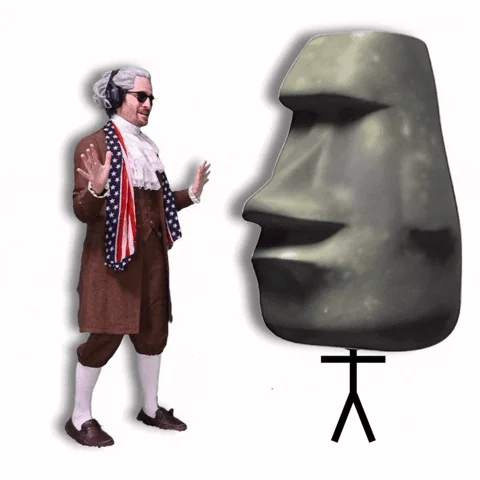Have you recently seen someone using the stone-face moai emoji while chatting and wondered what it could mean?
This quirky emoji might seem like another popular digital icon among Gen Z, TikTok users, and K-Pop fans. However, there’s much more beneath that rocky surface.
From its origins to its cultural significance and different interpretations, we’re about to take you on a fascinating journey to uncover what makes the Moai emoji unusual. Keep reading to learn about the Moai emoji’s meaning, historical significance, different interpretations of this mysterious stone-face emoji, and more.
So, ready to crack the code and learn what’s hiding behind that stoney expression? Let’s find out together!
Symbolism and Meaning of the Moai Emoji
The Moai emoji is more than just a stone face. It depicts the famous Moai statues on Easter Island, a remote volcanic island in the southeastern Pacific Ocean.

Various other names of Moai Emoji
- 🗿Easter Island
- 🗿Human Rock Carving
- 🗿Moai
- 🗿Moyai Statue
One of the differentiating aspects of these statues is their slate expressions. Sometimes, they even refer to something antique, mysterious, or ancient.
Understanding the meaning behind this emoji can provide valuable insights into its popularity and cultural significance.
Over time, the Moai emoji has become a famous symbol in modern communication with its stoic expression and distinctive appearance. Its meaning is often interpreted through its cultural context and how it is used in various online interactions.
1. Facial Expression
One of the most striking features of the Moai emoji is its neutral or stoic facial expression. This expression can be interpreted in several ways:
- Mystery and Intrigue: The neutral face can evoke a sense of mystery and intrigue, suggesting more to the story.
- Strength and Resilience: The stoic expression can also symbolize strength and resilience, suggesting an ability to withstand challenges.
- Indifference or Disinterest: In some contexts, the neutral face may be seen as a sign of indifference or disinterest.
2. Cultural Implications
The Moai emoji’s cultural implications are closely tied to the real-world Moai statues on Easter Island. These statues are believed to represent ancestors or deities and are often associated with:
- Spiritual Significance: The Moai emoji can symbolize spiritual connection or reverence for ancestors.
- Cultural Heritage: The emoji can also connect to cultural heritage and tradition.
3. Modern Usage
In modern online communication, the Moai emoji is often used to express:
- Humor: The emoji can be used humorously to convey a sense of stoicism or indifference in a playful way.
- Sarcasm: The neutral expression can also be used sarcastically to convey disbelief or frustration.
- Mystery: The emoji can create a sense of mystery or intrigue in a conversation.
If you are always fascinated by unusual faces and emojis, this guide on quandale dingle memes may interest you!
Origin And Historical Significance
The Moai statues hold deep historical significance. Carved between 1400 and 1650 CE, they are believed to represent the ancestors of the Rapa Nui people, who watched over the island and its inhabitants.
Regarding their origin, the Easter Island Rapa Nui people initially crafted the Moai statues. They were created to honor ancestors and historical leaders, serving as a symbol of respect and authority for them.
Intrigued by historical places and wish to visit one? You can now create your own using an AI dungeon.
Moai Emoji Big Head – What It Reveals?

Have you ever noticed the Moai emoji’s giant head? Well, it’s no accident. This reflects the Moai statues, which were designed with exaggerated head proportions.
The large heads symbolize the head’s importance in Polynesian culture, where the people consider it the epitome of intellectual and spiritual power.
Interesting Fact: Did you know the Moai emoji became part of the Unicode Standard in 2015, allowing users to incorporate a cultural artifact into their daily conversations?
Experience fun storytelling experiences by visiting this guide on AI storytelling tools.
What are Different Interpretations of the Moai Emoji?
Now that you have learned the meaning of the Moai Emoji and explored its origin, it’s time to explore different interpretations and how various people use it.
1. Ancient History
One classic way of using the stone face is when mentioning ancient history. For instance, if you use the sentence “I just finished reading about the ancient civilizations 🗿” you can add the moai emoji at the end.
2. Stoic Expression
You can also use the moai emoji to deliver a sense of calmness or composure. Using this emoji conveys a stone-cold demeanor. For example, “No matter how worse the situation gets, I will stay cool and collected.🗿”

Do you know who else is known for his stoic face? Shoto Todoroki. If you also like him, visit this guide to learn more about him!
3. Mystery and Intrigue
The moai emoji is perfect for adding a pinch of mystery to your conversations.
For instance, when revealing a secret to someone or talking about a mysterious building, the stone face emoji can make the conversation sound intense.
“Common sense remains a mystery 🗿”
4. Strength Symbol
As evident from the origin of the Moai emoji, it is a strength symbol, and one of the most significant uses of this emoji is at places where you talk about being strong.

For example: “We’ve faced tough times but are still standing strong. 🗿”
In this guide, learn about Kento Nanami, the strength symbol in Jujutsu Kaisen.
5. Seriousness
The moai emoji can even stress a solemn mood. For instance, you can add this emoji at the end of sentences like “Let’s keep our focus and stay serious about this. 🗿”
6. Cultural Appreciation
When showing appreciation for cultural heritage or landmarks in your conversations, use the moai emoji at the end.
For instance, when telling someone, “Learning about the Moai statues was fascinating! 🗿”
7. In Jokes and Memes
The Moai emoji has been involved in numerous social media trends and memes. It can be used humorously, particularly when making fun of someone for being unbothered or stoic.
One notable trend saw users sharing their “Moai selves” by superimposing the emoji’s face onto their photos. This trend playfully explored adopting the Moai’s stoic demeanor as a personal identity.
Another widespread use of the Moai emoji is in reaction images. Its neutral expression can convey various emotions, from indifference to amusement. It has become a go-to emoji for expressing a subtle or understated reaction to a situation or statement.
For example, “No matter how funny the situation gets, he never laughs. 🗿”
Check out this guide to find some funny acronym generators!
8. As a Placeholder
We all face situations where we are out of words or have no clue how to respond. This emoji is the perfect thing to fill the space in such situations.
For example, “I don’t have the words, but this emoji says it all. 🗿”
9. On Social Media
When you post pictures from your visit to historical places or cultural landmarks on various social media platforms, you can use the moai emoji in your captions.
For example: “Visited Easter Island and saw the Moai statues in person! 🗿”
Head to this guide to learn how AI is revolutionizing social media marketing.
10. Artistic Interpretations
The Moai emoji has also inspired various artistic interpretations, ranging from digital art to physical sculptures. Artists have explored the symbolism and cultural significance of the emoji, often reinterpreting it in their unique styles.
Some artists have even created a series of works based on the Moai emoji, such as sculptures, paintings, and digital artwork featuring the emoji in different contexts.
11. Brand Usage
Many brands have incorporated the Moai emoji into their marketing strategies to connect with their audience on a more relatable level. Some have used it to create playful and attention-grabbing visuals, while others have leveraged its cultural significance to connect with their audience.
For example, Some brands have created merchandise featuring the Moai emoji, such as t-shirts, stickers, and phone cases.
Moreover, a travel company might use the Moai emoji to promote Easter Island tours, highlighting the Moai statues’ historical and cultural significance.
Copy and paste this Moai Emoji to use it anywhere.
Where to Locate the Moai Emoji?

By now, you may be eager to start using the Moai emoji, especially after knowing about its fascinating backstory and versatile meanings. But locating the stone face on your keyboard can sometimes feel like a treasure hunt.
Don’t worry, though—we’ve got you covered!
Here’s a step-by-step guide to help you find the Moai emoji on various platforms, adding fun to your daily chats.
Where Is the Moai Emoji Located on the Keyboard?
Finding the Moai emoji on your keyboard is pretty simple. It is in most devices’ “Objects” section of your emoji keyboard.
However, using a PC, you can use the emoji picker tool, accessed through the right-click menu or a keyboard shortcut, e.g., “Windows + .” on Windows or “Control + Command + Space” on macOS.
Where Is the Moai Emoji Located on Android?
On Android devices, the Moai emoji can be found in the “Symbols” or “Objects” section of the emoji keyboard. To do this, tap the smiley face icon on your keyboard and navigate through the categories until you find the stone face.
The above steps can help you locate the moai emoji on WhatsApp, Messenger, or similar apps.
Here is how it looks on different platforms, so you can quickly locate it.
Learn about WhatsApp meta AI in this guide.
Wrap Up
And there you have it—a quick guide to the famous Moai Emjoi. Remember, the emoji is more than just a quirky stone face; it’s a symbol with a rich backstory and fun meanings and uses.
If you’re an emoji enthusiast, why not take your love of emojis to the next level and create AI characters of your favorite emojis on ChatFAI?
Using ChatFAI, you can customize an AI character based on the moai emoji and interact with it one-on-one. This chatbot even offers impressive chatbot memory, allowing you to engage in fun conversations with the character based on emojis without worrying about forgetting all your chats.
You can exchange voice chats with these bots to add more spice to the conversations.
Want to know more? Visit ChatFAI now to create your AI characters and experience the excitement firsthand!
FAQs
What Does the 🗿 Emoji Mean?
The 🗿 emoji, known as the Moai emoji, represents the iconic stone statues found on Easter Island, a remote volcanic island in the southeastern Pacific Ocean. It’s often used to convey a sense of stoicism, strength, or mystery.
What Statue is 🗿?
The 🗿 emoji depicts a Moai statue, a large, monolithic figure carved from volcanic rock. These statues are famous for their distinctive, elongated ears and neutral expressions.
What is the Name of the 🗿 Stone?
The 🗿 emoji is called the Moai emoji or stone face emoji, after the statues it represents.
What Does the 🪨 Mean?
The 🪨 emoji represents a stone, rock, or boulder. It often symbolizes strength, stability, or a connection to nature.
What is 🛐 Emoji Called?
The 🛐 emoji is called the “Place of Worship” emoji. It’s a generic symbol representing a place of worship, which could be linked with various religions or spiritual practices.
What Does 🛐 Mean?
The 🛐 emoji represents a place of worship, such as a church, mosque, or temple. It’s often used to symbolize religious faith—spirituality, or devotion.